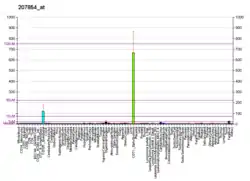| GYPE | |||||||||||||||||||||||||||||||||||||||||||||||||||
|---|---|---|---|---|---|---|---|---|---|---|---|---|---|---|---|---|---|---|---|---|---|---|---|---|---|---|---|---|---|---|---|---|---|---|---|---|---|---|---|---|---|---|---|---|---|---|---|---|---|---|---|
| Identifiers | |||||||||||||||||||||||||||||||||||||||||||||||||||
| Aliases | GYPE, GPE, MNS, MiIX, glycophorin E (MNS blood group), GYPA | ||||||||||||||||||||||||||||||||||||||||||||||||||
| External IDs | OMIM: 138590 HomoloGene: 136752 GeneCards: GYPE | ||||||||||||||||||||||||||||||||||||||||||||||||||
| |||||||||||||||||||||||||||||||||||||||||||||||||||
| |||||||||||||||||||||||||||||||||||||||||||||||||||
| Wikidata | |||||||||||||||||||||||||||||||||||||||||||||||||||
| |||||||||||||||||||||||||||||||||||||||||||||||||||
Glycophorin-E is a protein that in humans is encoded by the GYPE gene.[2]
The protein encoded by this gene is a sialoglycoprotein and a type I membrane protein. It is a member of a gene family with GPA and GPB genes. This encoded protein might carry the M blood group antigen. GYPA, GYPB, and GYPE are organized in tandem on chromosome 4. This gene might have derived from an ancestral gene common to the GPB gene by gene duplication. Two alternatively spliced transcript variants encoding the same protein have been described for this gene.[2]
References
- ↑ "Human PubMed Reference:". National Center for Biotechnology Information, U.S. National Library of Medicine.
- 1 2 "Entrez Gene: GYPE glycophorin E".
Further reading
- Cartron JP, Rahuel C (1992). "Human erythrocyte glycophorins: protein and gene structure analyses". Transfusion Medicine Reviews. 6 (2): 63–92. doi:10.1016/S0887-7963(92)70158-8. PMID 1591491.
- Huang CH, Skov F, Daniels G, et al. (1992). "Molecular analysis of human glycophorin MiIX gene shows a silent segment transfer and untemplated mutation resulting from gene conversion via sequence repeats". Blood. 80 (9): 2379–87. doi:10.1182/blood.V80.9.2379.2379. PMID 1421409.
- Vignal A, London J, Rahuel C, Cartron JP (1991). "Promoter sequence and chromosomal organization of the genes encoding glycophorins A, B and E". Gene. 95 (2): 289–293. doi:10.1016/0378-1119(90)90374-Z. PMID 2249783.
- Kudo S, Fukuda M (1990). "Identification of a novel human glycophorin, glycophorin E, by isolation of genomic clones and complementary DNA clones utilizing polymerase chain reaction". J. Biol. Chem. 265 (2): 1102–10. doi:10.1016/S0021-9258(19)40164-6. PMID 2295603.
- Vignal A, Rahuel C, London J, et al. (1990). "A novel gene member of the human glycophorin A and B gene family. Molecular cloning and expression". Eur. J. Biochem. 191 (3): 619–625. doi:10.1111/j.1432-1033.1990.tb19166.x. PMID 2390989.
- Kudo S, Fukuda M (1994). "Contribution of gene conversion to the retention of the sequence for M blood group type determinant in glycophorin E gene". J. Biol. Chem. 269 (37): 22969–74. doi:10.1016/S0021-9258(17)31605-8. PMID 7521873.
- Onda M, Fukuda M (1995). "Detailed physical mapping of the genes encoding glycophorins A, B and E, as revealed by P1 plasmids containing human genomic DNA". Gene. 159 (2): 225–230. doi:10.1016/0378-1119(95)00075-H. PMID 7622054.
- Kudo S, Onda M, Fukuda M (1995). "Characterization of glycophorin A transcripts: control by the common erythroid-specific promoter and alternative usage of different polyadenylation signals" (PDF). J. Biochem. 116 (1): 183–92. doi:10.1093/oxfordjournals.jbchem.a124492. PMID 7798177. S2CID 6290239. Archived from the original (PDF) on 2019-02-25.
- Huang CH, Chen Y, Blumenfeld OO (2000). "A novel St(a) glycophorin produced via gene conversion of pseudoexon III from glycophorin E to glycophorin A gene". Hum. Mutat. 15 (6): 533–540. doi:10.1002/1098-1004(200006)15:6<533::AID-HUMU5>3.0.CO;2-R. PMID 10862083. S2CID 21226892.
- Strausberg RL, Feingold EA, Grouse LH, et al. (2003). "Generation and initial analysis of more than 15,000 full-length human and mouse cDNA sequences". Proc. Natl. Acad. Sci. U.S.A. 99 (26): 16899–16903. Bibcode:2002PNAS...9916899M. doi:10.1073/pnas.242603899. PMC 139241. PMID 12477932.
- Wang HY, Tang H, Shen CK, Wu CI (2004). "Rapidly evolving genes in human. I. The glycophorins and their possible role in evading malaria parasites". Mol. Biol. Evol. 20 (11): 1795–1804. doi:10.1093/molbev/msg185. PMID 12949139.
- Gerhard DS, Wagner L, Feingold EA, et al. (2004). "The status, quality, and expansion of the NIH full-length cDNA project: the Mammalian Gene Collection (MGC)". Genome Res. 14 (10B): 2121–2127. doi:10.1101/gr.2596504. PMC 528928. PMID 15489334.
This article is issued from Wikipedia. The text is licensed under Creative Commons - Attribution - Sharealike. Additional terms may apply for the media files.
